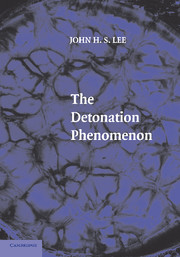Book contents
- Frontmatter
- Contents
- Preface
- 1 INTRODUCTION
- 2 GASDYNAMIC THEORY OF DETONATIONS AND DEFLAGRATIONS
- 3 DYNAMICS OF DETONATION PRODUCTS
- 4 LAMINAR STRUCTURE OF DETONATIONS
- 5 UNSTABLE DETONATIONS: NUMERICAL DESCRIPTION
- 6 UNSTABLE DETONATIONS: EXPERIMENTAL OBSERVATIONS
- 7 INFLUENCE OF BOUNDARY CONDITIONS
- 8 DEFLAGRATION-TO-DETONATION TRANSITION
- 9 DIRECT INITIATION OF DETONATIONS
- Epilogue
- Index
2 - GASDYNAMIC THEORY OF DETONATIONS AND DEFLAGRATIONS
Published online by Cambridge University Press: 06 July 2010
- Frontmatter
- Contents
- Preface
- 1 INTRODUCTION
- 2 GASDYNAMIC THEORY OF DETONATIONS AND DEFLAGRATIONS
- 3 DYNAMICS OF DETONATION PRODUCTS
- 4 LAMINAR STRUCTURE OF DETONATIONS
- 5 UNSTABLE DETONATIONS: NUMERICAL DESCRIPTION
- 6 UNSTABLE DETONATIONS: EXPERIMENTAL OBSERVATIONS
- 7 INFLUENCE OF BOUNDARY CONDITIONS
- 8 DEFLAGRATION-TO-DETONATION TRANSITION
- 9 DIRECT INITIATION OF DETONATIONS
- Epilogue
- Index
Summary
INTRODUCTION
For given initial and boundary conditions, the possible combustion waves that can be realized are given by the solutions of the steady one-dimensional conservation equations across the wave. Since the three conservation equations (of mass, momentum, and energy) and the equation of state for the reactants and products constitute only four equations for the five unknown quantities (p1, ρ1, u1, h1, and the wave velocity u0), an extra equation is required to close this set. For non-reacting gases, the solutions to the conservation equations were first investigated by Rankine (1870) and by Hugoniot (1887–1889), who derived the relationship between the upstream and downstream states in terms of a specified wave speed, pressure, or particle velocity downstream of the shock wave. Analysis of the solutions of the conservation equations also provided important information on the stability of shock waves and on the impossibility of rarefaction shocks in most common fluids. For reacting mixtures, similar analyses of the conservation laws were first carried out independently by Chapman (1889), Jouguet (1904), and Crussard (1907), but none of these investigators were aware of similar studies carried out by Mikelson (1890) in Russia. More thorough investigations of the properties of the solutions of these conservation laws were carried out later by Becker (1917, 1922a, 1922b), Zeldovich (1940, 1950), Döring (1943), Kistiakowsky and Wilson (1941), and von Neumann (1942). Their aim was to provide a more rigorous theoretical justification of the Chapman–Jouguet criterion.
- Type
- Chapter
- Information
- The Detonation Phenomenon , pp. 26 - 52Publisher: Cambridge University PressPrint publication year: 2008
- 4
- Cited by



